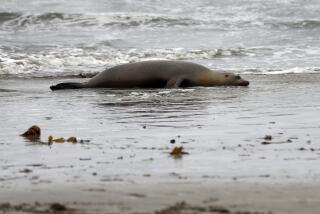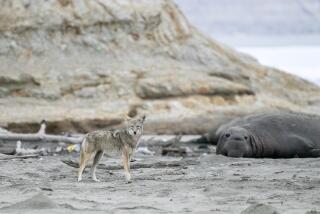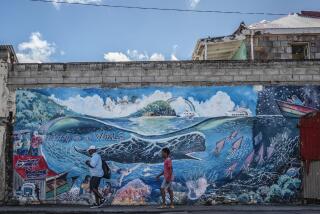Netherlands Sanctuary Cares for Sick Seals in Europe
- Share via
PIETERBUREN, Netherlands — Xavier the gray seal is lucky to be alive.
In March he was washed up on the Spanish coast near Bilbao, badly malnourished, riddled with parasitic worms and clearly dying.
Within hours of being found, he was aboard a specially chartered plane heading for a remarkable seal hospital on the northern Dutch coast where he is being nursed back to health.
Such mercy dashes have become routine for Lenie ‘t Hart, the 49-year-old director of the mainly privately funded sanctuary.
Usually they are a bit cheaper. “He’s our most expensive seal . . . there were no direct flights so we had to charter a plane,” said ‘t Hart. “I haven’t had the bill yet but it cost a lot, maybe 10,000 guilders ($5,000)).”
For the last 20 years ‘t Hart has devoted her life to caring for seals.
“People know when they have real problems they can always ask us,” she said.
‘T Hart started on her own in her back garden, working with orphaned baby seals, known as “whiners,” found along the Dutch coast. They get their name from the pitiful cry they make.
Today she heads a team of 22 and her center in the hamlet of Pieterburen is equipped to care for seals with special pools, a solarium and a freezer stuffed with 3 tons of herring.
By early 1988 the center had released more than 500 seals back into the Wadden Sea, which borders the Netherlands, Germany and Denmark. And the Dutch seal population had more than tripled to 1,200 from its mid-1970s low point.
Then, in April, 1988, disaster struck. A previously unknown seal virus appeared in the Kattegat area between Denmark and Sweden, spreading rapidly to the North Sea and the Baltic Sea.
By the end of 1988 more than 17,000 European harbor or common seals had died, with mortality rates in some areas exceeding 80%.
The population has since revived somewhat. An aerial survey last year counted 5,205 animals in the Wadden Sea, 15% more than a year earlier.
But the disease, which causes symptoms similar to distemper in dogs, is still there. Three of the 25 autopsies conducted on dead seals found along the Dutch coast last year showed infection with phocid distemper virus (PDV).
Its origins remain a mystery. Some scientists now believe PDV may have been present in some seal populations before 1988. Seals in Lake Baikal in Siberia have been found to be infected with a similar virus.
But why did the disease reach epidemic proportions in 1988? The prime suspects are toxic industrial wastes such as polychlorinated biphenyls (PCBs) and heavy metals such as mercury, swept down the Rhine and other European rivers.
“What we presume is that pollutants attack the cells, damaging the immune system as happens with AIDS,” ’t Hart said.
PCBs have already been shown to affect seals’ reproduction.
To test the theory, the Pieterburen center is feeding 11 seals with fish from the badly polluted Baltic Sea and 11 with fish from the relatively clean Atlantic. The joint experiment with two Dutch state institutes still has two years to run.
‘T Hart believes that unless pollution is severely cut, the tragedy three years ago could be repeated. “My fear is that there will be another epidemic. That’s why we have to do the research now,” she said.
The 1988 epidemic was curtailed because most of the survivors developed antibodies to the virus. Some got a helping hand from vaccinations at Pieterburen and a handful of other seal sanctuaries around Europe.
But a new generation of young seals is now growing up without these antibodies.
“If the virus stays virulent enough and the population of seals without antibodies grows, then there could be an explosive situation again,” said Pieterburen’s veterinary surgeon Lies Vedder.
More to Read
Sign up for Essential California
The most important California stories and recommendations in your inbox every morning.
You may occasionally receive promotional content from the Los Angeles Times.










